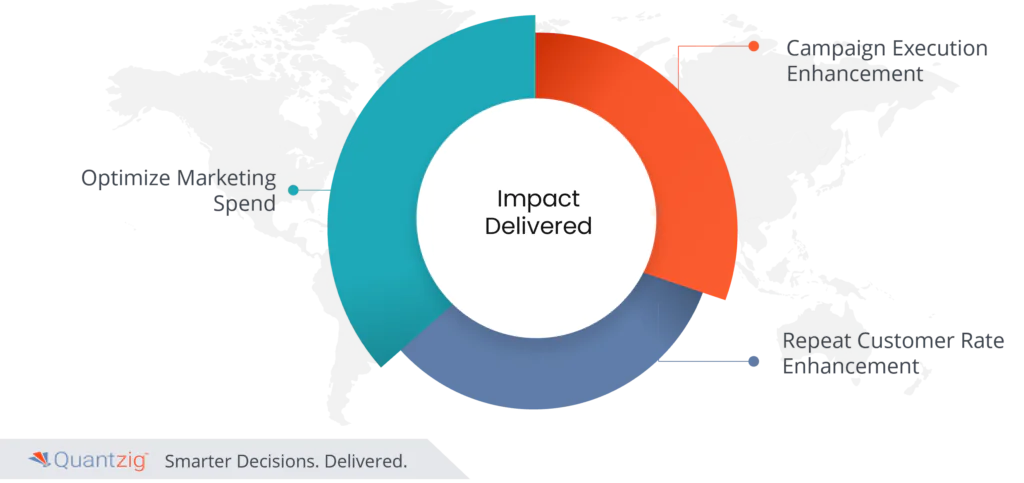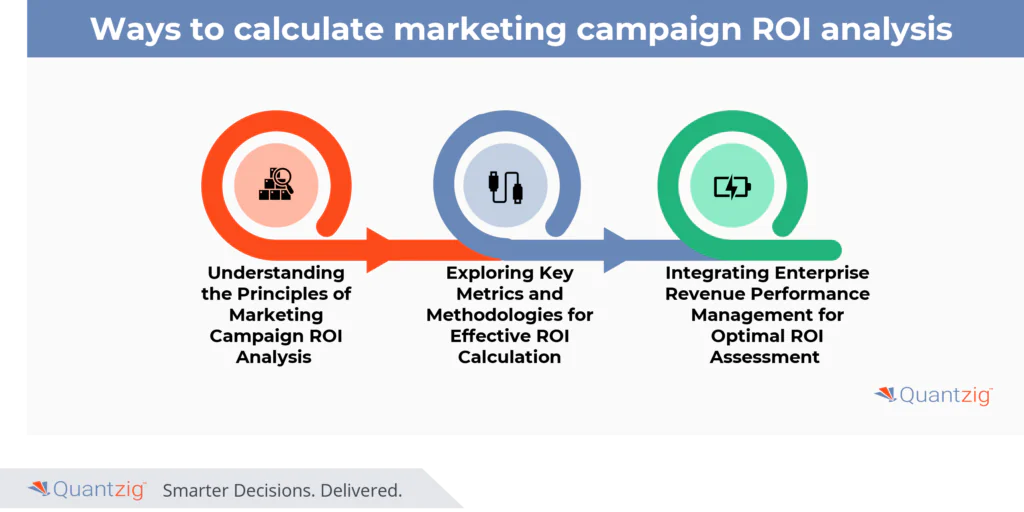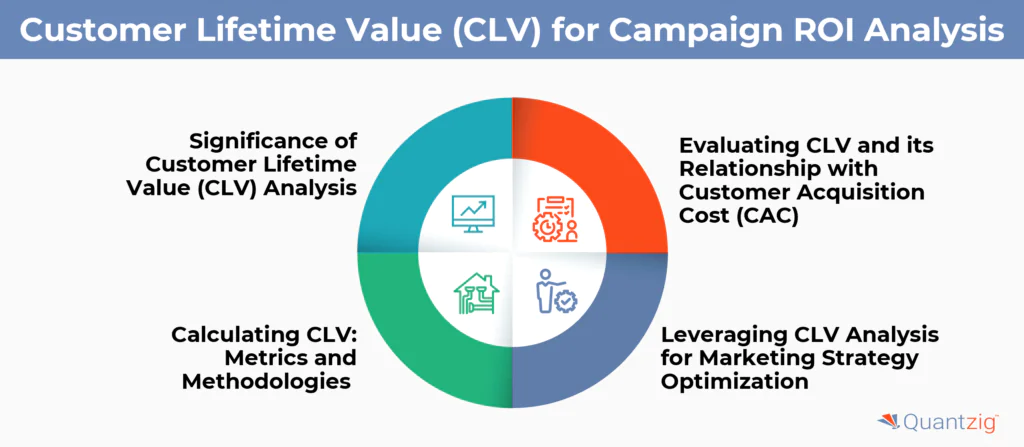Written By: Sudeshna Ghosh
Table of Contents
Key Takeaways of Campaign ROI Analysis
- Evaluating the ROI of marketing campaigns is crucial for optimizing strategies and maximizing returns. Metrics like customer acquisition cost and conversion rates offer insights into campaign effectiveness.
- Calculating ROI through the cost ratio method clarifies revenue generated per marketing dollar spent. Utilizing both direct and indirect revenue attribution models enhances understanding of effective touchpoints.
- CLV guides marketing efforts toward retaining existing customers and acquiring new ones cost-effectively. Understanding CLV about customer acquisition cost helps optimize marketing strategies.
- Implementing an enterprise revenue performance management strategy ensures informed decision-making in marketing budgeting. Aligning efforts with business goals and embracing data-driven insights enables efficient resource allocation for long-term success.
Introduction
One of the most essential components of any marketing campaign is to successfully evaluate its performance impact and profitability so that it can be measured whether or not your all marketing efforts are helping the organizations improve their bottom line. The valuable insights gained through this overall process can be used to drive successful future, data-driven marketing strategies for smarter decision-making. So, read the full case study to explore the concept of Campaign ROI Analysis.
Book a demo to experience the meaningful insights we derive from data through our analytical tools and platform capabilities. Schedule a demo today!
Request a Free DemoQuantzig’s Success Story
| Client Details | A leading multinational e-commerce retailer with a diverse product portfolio. |
| Challenges Faced by The Client | A lack of a comprehensive system to evaluate the performance of their marketing campaigns. |
| Solutions Offered by Quantzig | Quantzig helped the client by implementing advanced tracking mechanisms to monitor the performance of each marketing campaign in real-time. Our team developed custom dashboards and reporting templates to provide the client with actionable insights into their marketing ROI. |
| Impact Delivered | Identify underperforming campaigns and reallocate resources to initiatives with higher returns, optimize marketing spend, campaign execution enhancement, and repeat customer rate enhancement. |
Client Details:
Our client, a leading multinational e-commerce retailer with a diverse product portfolio, faced challenges in effectively measuring and optimizing their marketing ROI. With a vast customer base and multiple marketing channels, they struggled to decipher which campaigns were driving the most significant returns and where to allocate their resources for maximum impact.
Challenges Faced by the Client:
The client’s primary challenge lay in the lack of a comprehensive system to evaluate the performance of their marketing campaigns. They faced difficulty in attributing revenue to specific marketing efforts, resulting in inefficient resource allocation and missed opportunities for growth. Moreover, with the dynamic nature of the e-commerce industry, they needed real-time insights to adapt their strategies swiftly and stay ahead of the competition.
Solutions Offered by Quantzig:
Quantzig leveraged its expertise in data analytics and campaign optimization to develop a tailored solution for the client’s challenges. We began by implementing advanced tracking mechanisms to monitor the performance of each marketing campaign in real-time. By integrating data from various sources, including website analytics, customer behavior, and sales data, we created a holistic view of the client’s marketing ecosystem.
Utilizing sophisticated algorithms and predictive modeling, we identified key performance indicators (KPIs) and metrics to measure campaign effectiveness accurately. Our team developed custom dashboards and reporting templates to provide the client with actionable insights into their marketing ROI. Additionally, we offered strategic guidance on optimizing campaign strategies, reallocating budgets, and precision targeting high-value customer segments.
Impact Delivered:
The solutions implemented by Quantzig yielded significant results for the client. By gaining visibility into their marketing ROI, the client could identify underperforming campaigns and reallocate resources to initiatives with higher returns. Our data-driven approach enabled them to optimize their marketing spend, resulting in a notable increase in revenue and profitability.
Furthermore, the client achieved greater agility in responding to market trends and consumer behavior changes. With real-time insights and predictive analytics, they could adjust their strategies on the fly, maximizing their competitive advantage in the e-commerce landscape.
Overall, Quantzig’s partnership empowered the client to make informed, data-driven decisions, driving substantial improvements in their marketing ROI and positioning them for sustained growth in the digital marketplace.
In conclusion, our collaboration with the client exemplifies the transformative power of data analytics in maximizing marketing ROI and driving business success in today’s competitive landscape.
Also Read: Campaign Effectiveness Optimization: Best Business Practices
Get started with your complimentary trial today and delve into our platform without any obligations. Explore our wide range of customized, consumption driven analytical solutions services built across the analytical maturity levels.
Start your Free Trial TodayCampaign ROI Analysis: An Overview

Campaign ROI analysis is a fundamental aspect of evaluating the effectiveness and success of marketing initiatives. It involves assessing the Return on Investment (ROI) generated from various campaigns, and measuring the revenue generated against the costs incurred. By analyzing key performance indicators and metrics such as customer acquisition cost, campaign costs, conversion rates, month-over-month sales growth, and overall revenue, businesses can gain valuable insights into the performance of their marketing efforts. This analysis not only enables businesses to identify high-performing campaigns but also provides actionable insights for optimizing future campaign strategies and allocating resources effectively. Ultimately, campaign ROI analysis serves as a cornerstone for data-driven decision-making, driving continuous improvement and maximizing return on investment in marketing endeavors.
Measuring the return on investment (ROI) of marketing efforts is paramount for organizations aiming to maximize their profitability and drive sustainable growth. Campaign ROI analysis entails evaluating the effectiveness of marketing initiatives across various business lines and campaigns. By assessing key metrics such as marketing cost, revenue generated, and business performance, businesses can gain valuable insights into their marketing ROI. Leveraging enterprise revenue performance management strategies and advanced analytics tools like web analytics, campaign analytics, and customer relationship management (CRM) systems, organizations can track and measure the impact of marketing programs on revenue generation. This holistic approach enables businesses to optimize their marketing spend, identify cost-effective channels, and enhance overall business performance.
Furthermore, campaign ROI analysis extends beyond individual campaigns to encompass cross-channel marketing analysis and performance measurement. By analyzing conversion rates, conversion metrics, and total traffic across multiple marketing channels, organizations can gain a comprehensive understanding of their marketing effectiveness. This comprehensive analysis enables businesses to identify high-performing campaigns and advertising platforms, optimize campaign strategies, and allocate resources efficiently. Moreover, by focusing on audience engagement metrics and leveraging insights from ROI (Return on Investment) calculations, organizations can tailor their marketing programs to resonate with their target audiences effectively. Ultimately, campaign ROI analysis serves as a cornerstone for data-driven decision-making, enabling organizations to maximize their Marketing ROI (MROI) and drive long-term business success.
Experience the advantages firsthand by testing a customized complimentary pilot designed to address your specific requirements. Pilot studies are non-committal in nature.
Request a Free PilotCalculating Marketing Campaign ROI Analysis
1. Understanding the Principles of Marketing Campaign ROI Analysis
Measuring the effectiveness of marketing campaigns is crucial for businesses to optimize their strategies and maximize return on investment (ROI). One key aspect of baseline MROI calculations is understanding how to calculate marketing campaign ROI analysis. This involves evaluating various metrics such as cost per acquisition (CPA) ratio, conversion rates, campaign costs, and performance measurement across different marketing programs and campaigns. By leveraging web analytics, marketing attribution modeling, campaign analytics, and customer relationship management (CRM) systems, organizations can gain insights into the total traffic generated by their campaigns and assess the conversion metrics to determine the effectiveness of their marketing efforts. Additionally, conducting cross-channel marketing analysis allows businesses to evaluate the impact of their campaigns across multiple channels, ensuring a comprehensive understanding of ROI (Return on Investment).
2. Exploring Key Metrics and Methodologies for Effective ROI Calculation
Determining marketing ROI can be approached through various methods, each offering insights into campaign effectiveness. One such method is the cost ratio, which calculates the revenue generated for every marketing dollar spent. For instance, a 5:1 cost ratio signifies $5 generated for every $1 invested, equating to a simple ROI of 400%. Alternatively, direct and indirect revenue attribution models offer nuanced perspectives. Direct attribution assigns all revenue from a sale to a single marketing touchpoint, often the last one before purchase. Conversely, indirect attribution distributes revenue evenly across all interactions. By utilizing both attribution models, marketers gain a holistic view, enabling comparisons between effective touchpoints and those influential across multiple sales. This approach integrates Marketing ROI (MROI) seamlessly into broader revenue performance management strategies.
3. Integrating Enterprise Revenue Performance Management for Optimal ROI Assessment
Furthermore, to calculate marketing campaign ROI effectively, businesses must consider the enterprise revenue performance management strategy in place. This involves aligning marketing objectives with overall business goals and optimizing marketing campaigns and advertising strategies accordingly. By analyzing campaign costs and comparing them against the generated revenue, organizations can derive accurate ROI (Return on Investment) calculations. Additionally, focusing on audience engagement metrics enables businesses to understand the level of interaction and interest generated by their campaigns, providing valuable insights for future optimization. Ultimately, mastering the art of calculating marketing campaign ROI analysis empowers organizations to make data-driven decisions, allocate resources efficiently, and drive sustainable business growth.
In short, the simplest way to calculate the ROI of a marketing campaign is to incorporate it into the overall business line calculation. To do this, take the sales growth from that business or product line, subtract the marketing costs, and then divide by the marketing costs.
Ways to Conduct a Campaign ROI Analysis
Measuring campaign return on investment (ROI) is paramount for businesses seeking to optimize their marketing strategies and drive growth. While traditional metrics like revenue generated and cost per acquisition are essential, diversifying measurement perspectives by exploring alternative ROI metrics offers a more comprehensive understanding of campaign effectiveness. This approach enables marketers to uncover hidden insights, refine their marketing tactics, and maximize the impact of their campaigns.
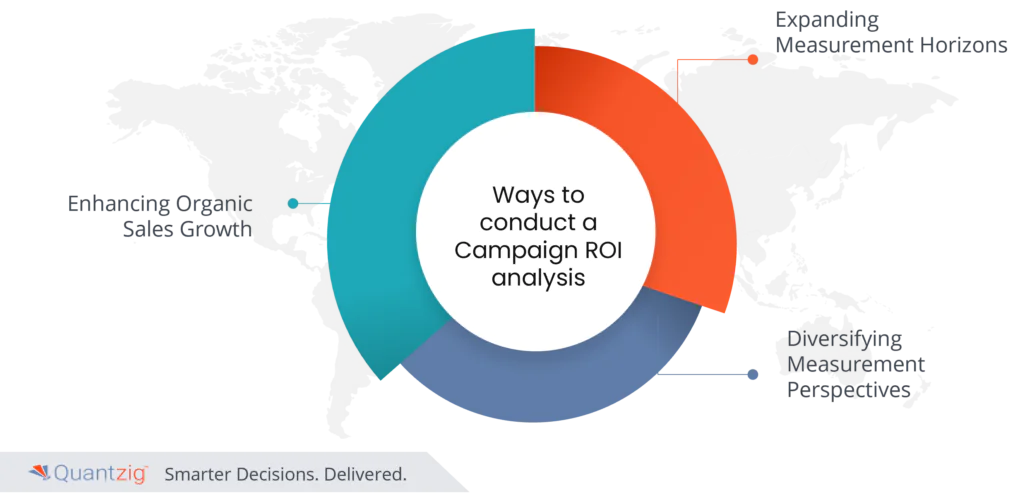
1. Enhancing Organic Sales Growth Through Holistic ROI Measurement
Campaign ROI Measurement goes beyond traditional metrics to integrate a comprehensive assessment of various factors that drive organic sales growth. By evaluating the example set by successful marketing campaigns and recognizing emerging trends, businesses can gain in-depth insights into what drives success and how to replicate it. Besides, analyzing various instances of negative sales growth within a particular time period provides valuable insights into improvement areas. Integrating a multiple-touch process to assess the significant impact across different touchpoints and target markets ensures a thorough customer segmentation evaluation. Collaborating with many marketing agencies enables the consideration of soft metrics such as media mentions, marketing attribution modeling, brand awareness, and social media likes, alongside hard metrics like content output rate and sales leads. Furthermore, involving sales staff in the campaign measurement process provides firsthand insights into campaign effectiveness, customer segmentation, customer lifecycle analysis, and facilitates a holistic approach to measuring campaign ROI in other ways.
2. Expanding Measurement Horizons: Beyond Traditional Metrics
To comprehensively evaluate campaign ROI and gauge its impact on organic sales growth, consider employing a multifaceted approach encompassing various soft metrics like brand awareness, media mentions, and social media likes, alongside hard metrics such as conversion rate and sales leads. Incorporating insights from real estate analysis reports and qualifying filters helps assess the effectiveness of hybrid campaigns and their resonance with the target market. By scrutinizing email leads and paid sales, businesses can glean valuable insights into future sales growth, campaign performance, ultimately driving increased sales and optimizing marketing spend for maximum Marketing ROI (MROI) across diverse marketing programs.
3. Diversifying Measurement Perspectives: Exploring Alternative Campaign ROI Metrics
In enhancing campaign ROI evaluation, businesses can adopt a multifaceted approach beyond traditional metrics. By scrutinizing the cost per acquisition (CPA) ratio alongside the sales cycle days, organizations gain insights into efficiency and effectiveness throughout the customer journey. Additionally, analyzing engagement duration and cost ratios provides a deeper understanding of audience interaction and resource allocation. Assessing the revenue generated against marketing dollars spent offers a tangible measure of campaign effectiveness, while tracking marketing leads aids in assessing lead quality and conversion potential. Incorporating both marketing attribution modeling like direct revenue attribution and indirect revenue attribution allows for a comprehensive evaluation of campaign impact on overall enterprise revenue performance, aligning with a robust enterprise revenue performance management strategy. Finally, optimizing tactics such as bidding for keywords, commissioning content, and sponsoring events ensures a diversified approach to maximizing campaign ROI across various business objectives.
Measuring campaign ROI analysis through diversified perspectives is crucial for businesses aiming to achieve optimal results from their marketing efforts. By considering a range of metrics beyond traditional measures, such as engagement duration, indirect revenue attribution, and enterprise revenue performance management strategies, businesses can gain deeper insights into the effectiveness of their campaigns, customer segmentation, and customer lifecycle analysis. This holistic approach empowers organizations to make data-driven decisions, refine their marketing campaign strategies, optimize advertising spend, and ultimately drive sustainable growth and success.
What are the Challenges of Calculating Campaign ROI?
Accurately measuring marketing ROI is paramount for informed decision-making and sustainable growth. However, businesses face several challenges in this endeavor, ranging from the complexity of attribution modeling to data quality and integration issues. These hurdles can impede the ability to gauge the true effectiveness of marketing efforts and optimize resource allocation accordingly. Understanding and addressing these challenges are essential steps towards achieving actionable insights and maximizing ROI.
1. Attribution Complexity:
Determining the exact impact of each marketing channel on ROI poses a significant challenge due to the complexity of attribution models. With customers interacting across multiple touchpoints, such as loyalty programs, check-in emails, and various marketing campaigns, attributing conversions to specific channels becomes intricate. This complexity is further compounded in e-commerce environments, where customers navigate through various channels before making a purchase. As a result, accurately attributing ROI to individual marketing efforts remains a formidable challenge for businesses.
Businesses grapple with accurately assigning credit to various marketing channels and touchpoints along the customer journey. Factors such as multi-touch attribution models, conversion metrics, and offline marketing efforts contribute to this complexity. Deciphering which interactions drive conversions, considering email, display ads, push notifications, media buys, and forums, poses a substantial hurdle. Without robust attribution models and sophisticated analytics tools, businesses may struggle to accurately measure the impact of each marketing initiative on overall ROI.
2. Data Integration and Analysis:
Integrating and analyzing data from diverse sources, including product specialists, data warehouses, and engagement metrics, presents another hurdle in calculating marketing ROI. Challenges arise in consolidating data from disparate channels and platforms, such as e-commerce channels, advertising platforms like Google AdWords, media buys, and Facebook Ads, and store visits. Moreover, accurately tracking and measuring conversions, funnel progression, and campaign costs across these channels require robust data analytics capabilities. Ensuring data accuracy, completeness, and relevance is crucial for deriving actionable insights and making informed marketing decisions amidst the vast array of marketing challenges.
From person-hour cost tracking to media spend analysis, businesses must harmonize data from disparate sources like spreadsheets, email outreach, and text-based marketing. Issues such as incomplete or inconsistent data, along with difficulties in integrating offline marketing data, hinder accurate performance measurement. Achieving a unified view of total traffic, conversion rates, and audience engagement metrics becomes challenging without robust data management practices and advanced analytics capabilities.
While the challenges of calculating marketing ROI may seem daunting, they present opportunities for businesses to refine their strategies and enhance their analytical capabilities. By tackling attribution modeling complexities and prioritizing data quality and integration, organizations can unlock valuable insights into their marketing performance. With the right tools, methodologies, and a commitment to continuous improvement, businesses can navigate these challenges effectively and drive measurable results that propel them towards their growth objectives.
Best Practices of Measuring Campaign ROI
Measuring marketing ROI is crucial for businesses to gauge the effectiveness of their strategies and allocate resources wisely. By implementing best practices, organizations can ensure accurate measurement and optimization of their marketing efforts. Here are two key practices that encompass various aspects of measuring marketing ROI.
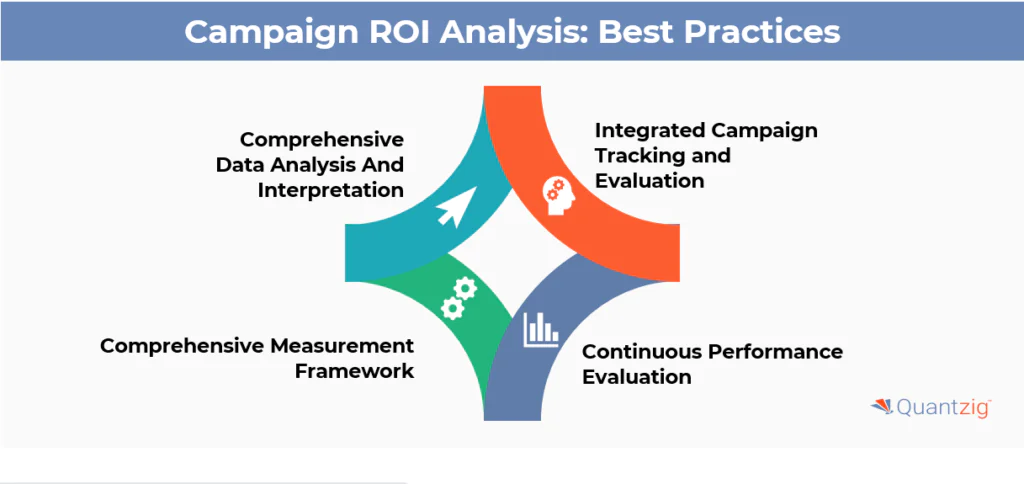
1. Comprehensive Data Analysis and Interpretation:
Begin by collecting data from diverse sources such as marketing dashboards, traffic metrics, and engagement metrics. Analyze these metrics thoroughly to gain insights into ad spend efficiency, content optimization, and customer journey mapping. By segmenting audiences and monitoring real-time data, businesses can identify trends and patterns that inform future strategy formulation. Continuous improvement relies on a deep understanding of these metrics and their implications for sales strategies, product development, and customer support protocols.
2. Integrated Campaign Tracking and Evaluation:
Implement a robust system for tracking marketing campaigns across multiple channels, including social media campaigns, sales campaigns, and product launch campaigns. Utilize KPIs such as conversion metrics, revenue metrics, and brand reputation to evaluate the success of each campaign. Foster cross-departmental collaboration to ensure alignment between marketing efforts and overall business goals. By continuously monitoring performance and adapting strategies based on data-driven insights, organizations can optimize their marketing ROI and drive long-term success.
3. Comprehensive Measurement Framework:
Establish a robust framework for measuring marketing ROI that incorporates both financial and strategic metrics. Begin by defining clear business goals aligned with ROI-positive marketing strategies. Utilize digital tools and reporting analytics tools to track key metrics such as cost-per-click, click-through rates, and conversion tracking data. Conduct regular testing and experimentation, including A/B testing, to optimize sales channels and improve core metrics. By integrating customer research and personas into the analysis, businesses can gain valuable insights to inform future marketing strategies and drive long-term success.
4. Continuous Performance Evaluation:
Implement a continuous evaluation process to monitor the effectiveness of current marketing strategies and make data-driven decisions. Utilize web analytics to track sales projections, cash flow problems, and unit economics in real-time. Conduct SWOT analysis to identify strengths, weaknesses, opportunities, and threats in the market landscape. Regularly review marketing budgets and financial investments to ensure alignment with business goals and maximize MER (Marketing Efficiency Ratio). Leverage LinkedIn Marketing Solutions and LinkedIn Ads for B2B lead generation campaigns, supported by insights from the LinkedIn ROI Research Report. By continuously assessing performance against investment costs and net profit, businesses can refine their marketing approaches and achieve sustainable growth.
Measuring marketing ROI requires a systematic approach that encompasses various best practices, including comprehensive data analysis, integrated campaign tracking, and cross-departmental collaboration. By following these practices and leveraging key metrics such as engagement, conversion, and revenue, businesses can continuously improve their marketing strategies, optimize resource allocation, and achieve greater success in the dynamic landscape of modern marketing.
Customer Lifetime Value (CLV) for Campaign ROI Analysis
1. Significance of Customer Lifetime Value (CLV) Analysis
Understanding Customer Lifetime Value (CLV) is essential for gauging the comprehensive value derived from a customer’s engagement with your brand over time. This metric signifies the total worth of a customer’s business throughout their relationship with your company. Its significance lies in the fact that retaining existing customers is generally more cost-effective than acquiring new ones. Hence, directing marketing efforts towards nurturing and engaging with current customers can be a potent strategy for driving sustainable growth.
2. Evaluating CLV and its Relationship with Customer Acquisition Cost (CAC)
CLV is closely intertwined with another crucial metric: Customer Acquisition Cost (CAC). CAC encompasses the investment required to acquire new customers, encompassing expenses like advertising, marketing campaigns, and promotional offers. Considering the total value of a customer’s purchases throughout their lifecycle is vital when evaluating CAC. By understanding both CLV and CAC, businesses can optimize their marketing strategies to focus on retaining existing customers while efficiently acquiring new ones.
3. Calculating CLV: Metrics and Methodologies
Calculating CLV involves assessing the average order value and multiplying it by the customer’s repeat rate, obtained through analyzing their purchase history. Additionally, brand loyalty plays a pivotal role in CLV calculation. Loyal customers are more inclined to make repeat purchases, thus contributing significantly to long-term revenue. Therefore, investing in initiatives such as loyalty programs, personalized marketing campaigns, and proactive customer engagement efforts becomes imperative for fostering brand loyalty and maximizing CLV.
4. Leveraging CLV Analysis for Marketing Strategy Optimization
Understanding and determining customer lifetime value (CLV) is pivotal for businesses aiming to gauge the long-term revenue potential and overall marketing ROI derived from their customer relationships. By analyzing marketing cost, campaigns, and advertising strategies alongside conversion rates, conversion metrics, and total traffic, organizations can gain valuable insights into the CLV of their customer base. Leveraging tools such as web analytics, campaign analytics, and customer relationship management (CRM) systems, coupled with cross-channel marketing analysis, allows businesses to comprehensively assess the performance and engagement levels of their marketing efforts across different marketing programs and business lines. Incorporating cost-per-acquisition (CPA) ratio calculations and employing an effective enterprise revenue performance management strategy further enhances the accuracy of CLV determinations, enabling organizations to optimize their marketing strategies, advertising spend, and drive sustained business growth.
Conclusion
In conclusion, maximizing marketing budget optimization through Campaign ROI Analysis is paramount for businesses striving to achieve optimal returns on their investments. By meticulously assessing marketing cost and campaigns alongside key metrics such as marketing ROI, media buys, revenue, conversion rates, and conversion metrics, organizations can gain valuable insights into the effectiveness of their marketing strategies.
Leveraging tools like web analytics and customer relationship management (CRM) systems, coupled with cross-channel marketing analysis, enables comprehensive evaluation of campaign performance across various marketing programs and business lines. Incorporating cost-per-acquisition (CPA) ratio calculations and adopting an effective enterprise revenue performance management strategy further enhances the accuracy of ROI determinations. By prioritizing performance measurement and audience engagement, marketers can optimize resource allocation, advertising spending, and drive sustained growth, ensuring maximum impact from their marketing budgets.

